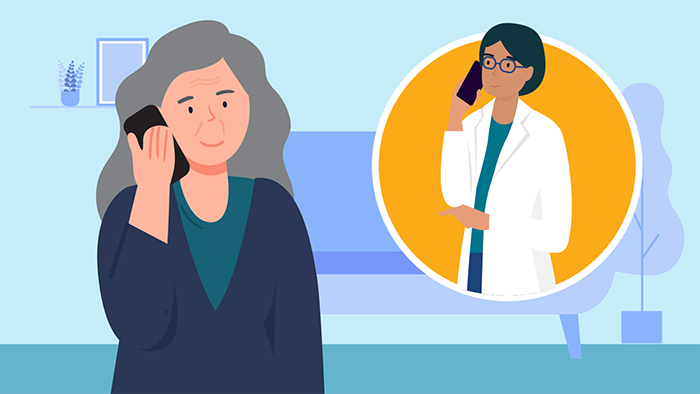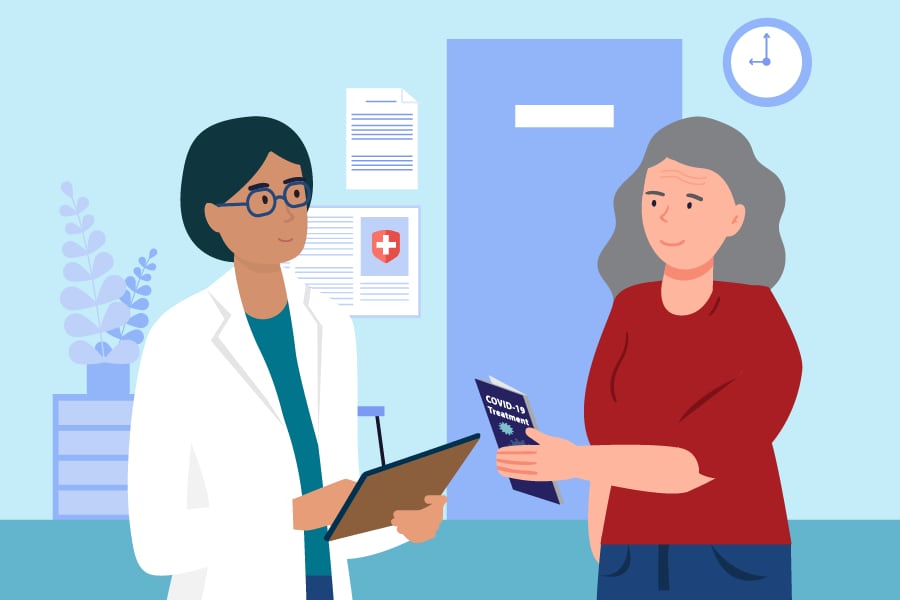Recommendations for Fully Vaccinated People
COVID-19 Homepage
COVID-19 Treatment and Preventive Medication
This page provides a treatment overview for the general public.
For healthcare providers: Interim Clinical Considerations for COVID-19 Treatment and Pre-exposure Prophylaxis in Outpatients
- If you have COVID-19 and are more likely to get very sick from COVID-19, treatment is available that can reduce your risk of hospitalization and death.
- Don’t delay: Treatments must be started within 5-7 days after you first develop symptoms.
- Other medications can help reduce symptoms and help you manage your illness.
- The Treatment Locator (hhs.gov) can help you find a location that offers testing and treatment or a pharmacy where you can fill your prescription.
- Learn more about what to do if you are sick.
Treating COVID-19

Most people with COVID-19 have mild illness and can recover at home. You can treat symptoms with over-the-counter medicines, such as acetaminophen or ibuprofen, to help feel better.
If you have COVID-19 and are more likely to get very sick from COVID-19, treatments are available that can reduce your chances of being hospitalized or dying from the disease. Medications to treat COVID-19 must be prescribed by a healthcare provider or pharmacist and started within 5–7 days after symptoms appear. Contact a healthcare provider right away to determine if you are eligible for treatment, even if your symptoms are currently mild.
Don’t delay: Treatment must be started within 5–7 days of when you first develop symptoms.
People who are more likely to get very sick include:
- Older adults (especially those ages 65 years or older, with risk further increasing with advancing age),
- People who are unvaccinated or are not up to date on their COVID-19 vaccinations,
- People with certain medical conditions, such as chronic lung disease, heart disease, or a weakened immune system.
Staying up to date with your COVID-19 vaccinations makes you much less likely to get very ill, be hospitalized, or even die from COVID-19. Treatments can further reduce the risk for COVID-19 hospitalization and death among vaccinated people, especially those at higher risk for severe illness. A healthcare provider will help decide whether treatment is right for you. Check with your healthcare provider or pharmacist if you are taking other medications to make sure the COVID-19 treatments can be safely taken at the same time.
Treatments

FDA has authorized or approved several antiviral medications used to treat mild to moderate COVID-19 in people who are more likely to get very sick.
- Antiviral treatments for COVID-19 target specific parts of the virus to stop it from multiplying in the body once someone is infected, helping to prevent severe illness and death.
- The Infectious Diseases Society of America provides Guidelines on the Treatment and Management of Patients with COVID-19 for healthcare providers to help them work with their patients and determine the best treatment options for them. Several treatment options are available for treating COVID-19. They do not treat other common respiratory viruses such as flu. COVID-19 treatment options include:
Some treatments might have side effects or interact with other medications you are taking. If you don’t have a healthcare provider, visit a Test to Treat location or contact your local community health center or health department.
If you are hospitalized, your healthcare provider might use other types of treatments, depending on how sick you are. These could include medications to better recognize and respond to the virus, treat the infection, reduce an overactive immune response, or treat COVID-19 complications.
If you have a weakened immune system, have received antiviral treatment, and continue to experience COVID-19 symptoms, your healthcare provider may recommend additional treatment, including convalescent plasma.
COVID-19 Rebound
COVID-19 rebound is a return of symptoms or a new positive test 3-7 days after recovering from the initial illness, or after having tested negative for SARS-CoV-2, the virus that causes COVID-19. People may experience rebound whether they received COVID-19 antiviral treatment or not. Rebound symptoms are typically mild.
Studies suggest there is no increased risk of severe COVID-19 illness in people who experience COVID-19 rebound after antiviral treatment.
The benefits of COVID-19 treatment outweigh the risk of rebound if you are at high risk for severe COVID-19. Talk to your healthcare provider if you think you may have rebound. If you don’t have a healthcare provider, visit a Test to Treat location or contact your local community health center or health department.
Watch ASL Video: Get Treatment for COVID-19
Click the button below or call 1-800-232-0233 (TTY 1-888-720-7489) to find a location that offers testing and treatment or a pharmacy where you can fill your prescription.
View LocationsCOVID-19 oral antiviral treatments Paxlovid and Lagevrio are available on the commercial market. Patient assistance programs are available to people who are underinsured, uninsured, or on Medicaid or Medicare to lower their out-of-pocket costs. You should enroll in these programs to learn if you can receive assistance for specific medications, regardless of your insurance status. Call ahead to your healthcare provider and insurer to confirm coverage eligibility.
The right medications for COVID-19 can help. But people have been seriously harmed and even died after taking products not approved or authorized for use to treat or prevent COVID-19, even products approved or prescribed for other uses. Talk to your healthcare provider about taking medications to treat COVID-19.
Preventing COVID-19
COVID-19 vaccines
COVID-19 vaccines available in the United States effectively protect people from getting seriously ill, being hospitalized, and even dying. As with vaccines for other diseases, you are protected best when you stay up to date. People who are moderately or severely immunocompromised may get additional doses of updated COVID-19 vaccines. People aged 65 and older should receive 1 additional dose of an updated COVID-19 vaccine. CDC recommends that everyone who is eligible stay up to date on their COVID-19 vaccines.
Pre-exposure Prophylaxis (Medication for Preventing COVID-19)
FDA has authorized a preventive monoclonal antibody for people who are moderately or severely immunocompromised, ages 12 years and older, and weighing at least 88 pounds. In addition to vaccination, Pemivibart (Pemgarda™) may provide another layer of protection against COVID-19 and can be given at least 2 weeks after receiving a COVID-19 vaccine.
A healthcare provider gives Pemgarda as a single intravenous infusion over 60 minutes at a doctor’s office or healthcare facility. If continued protection is needed, additional doses should be administered every 3 months.
People who are privately insured or have Medicare part B may receive Pemgarda for free. Talk to your healthcare provider to see if Pemgarda is right for you.
To find COVID-19 vaccine locations near you: Search vaccines.gov, text your ZIP code to 438829, or call 1-800-232-0233.
General Treatment Resources
Oral Antiviral Treatment Resources
To receive email updates about COVID-19, enter your email address: